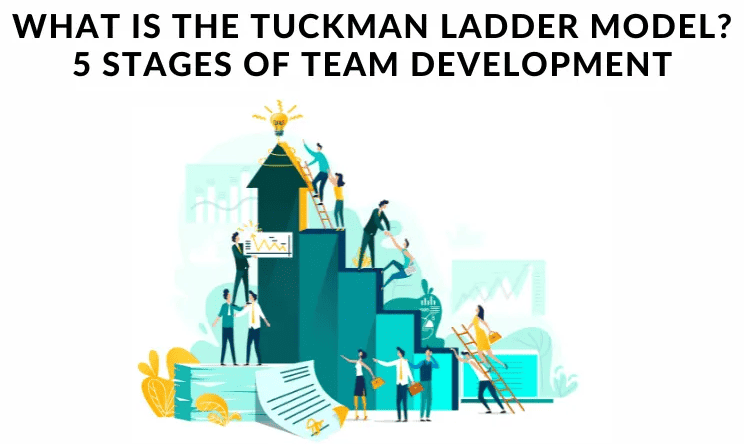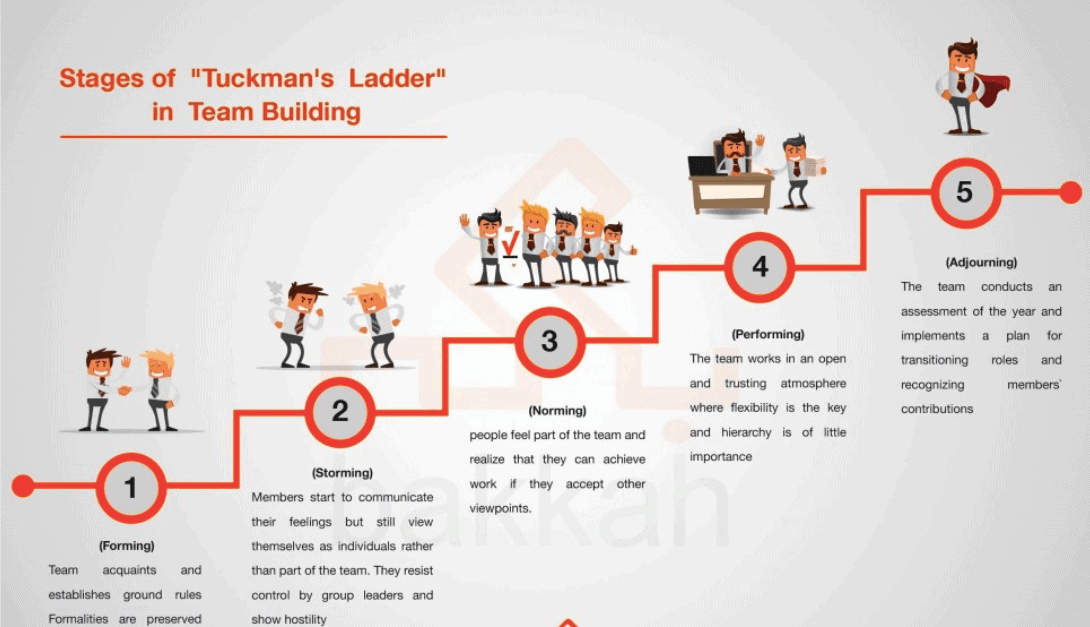
The Tuckman Ladder Model is a popular framework for understanding team dynamics. The model describes teams’ four stages as they work together: forming, storming, norming, and performing. This makes a team development process very important in project management, as it empowers individuals and teams to work together to achieve a common goal.
In project management, team development is creating and managing a team of individuals who work together to achieve a common goal. This process includes activities such as team building, member selection, training, and performance management.
In 1965, Bruce Tuckman proposed the Tuckman Ladder Model, a four-stage model of team development. This model is widely used in businesses and organizations as it provides a framework for understanding how teams form and develop over time.
An effective team development process is essential for any project manager who wants to build a high-performing team. By taking the time to develop your team, you can improve communication, increase collaboration, and boost overall team performance.
According to the model, groups go through four main stages: forming, storming, norming, and performing.
What is Team Development?
Project management is organizing and executing a project from start to finish. It involves planning, setting deadlines, assigning tasks, and tracking progress.
Team development involves bringing together a team of people with different skills and knowledge to work on a project. The team members must work together efficiently and effectively to achieve the project goals.
There are a few critical elements to team development:
Defining roles and responsibilities: Each team member should have a clear role and responsibility.
Establishing communication channels: The team needs to have a straightforward way to communicate with each other, whether that is through email, instant messaging, or regular meetings.
Setting goals and deadlines: Once the goals and objectives are identified, the team leader must then identify the individual skills and knowledge that each team member will need to achieve these goals.
The 5 stages of the Tuckman Ladder Model

The model describes teams’ four stages as they work together: forming, storming, norming, and performing. Each stage has its challenges and opportunities, and teams must overcome these challenges to reach the next stage of a project by working together more effectively.
1. Forming
In the forming stage, team members get to know each other and establish ground rules. This is typically a period of low conflict, as team members are still getting to know each other. Establish ground rules and make sure team members understand their roles and duties. For example, this can happen during a kickoff meeting.
2. Storming
The storming stage is when team members start to disagree, and conflict begins to arise. This is an ordinary and necessary moment as members are still trying to figure out their roles. Through promoting leadership, open communication between team members, and continual team communication.
3. Norming
The Norming stage is when the group starts to work together and gel as a unit. Team building exercises and honest feedback will encourage your team to bond properly
4. Performing
The performing stage is when the group is functioning at its best. Give honest and helpful comments when you know it is necessary. Try to engage in little intervention but only assist the team so it can become self-organizing.
5. Adjourning
The adjourning stage is sometimes added to the model to describe the team’s disbandment or completion of a project. Here happens where the completion of the project must be celebrated. It is important to provide support and recognition to your team so they would feel rewarded.
The Importance of the Tuckman Ladder Model in Project Management
The Model is a well-known framework for understanding team development. This tool will encourage you to understand how groups develop and change over time. Understanding the model can help you to manage your team more effectively and help them reach their potential.
Benefits of using the Tuckman ladder model in team development
- It helps teams identify their stage of development.
- It can help you to manage your team more effectively
- It can help you to identify team strengths and weaknesses, which will allow you to make future improvements
- It emphasizes the importance of team cohesiveness.
- It can help team members understand and respect each other’s roles, highlighting the importance of effective communication.
COG’S Ladder Vs. Tuckman Ladder
There are many different models for team development, but two of the most commonly used are Tuckman’s Ladder and the COGs Ladder. Both models have a similar goal: to help teams grow and develop over time. However, there are some key differences between the two models.
So which model is better?
| Team Development stages according to COG’s and Tuckman’s |
| COG’s Ladder | Tuckman’s Theory |
|---|---|
| Polite | Forming |
| Why we are here | Storming |
| Bid For Power | Norming |
| Constructive | Performing |
| Esprit * | Adjourning |
COG’s Ladder is more simplistic and easy to understand.
Tuckman’s Ladder is more detailed and includes a fifth stage (adjourning).
Some experts believe that the fifth stage is essential for teams that need to disband after completing a project.
Tuckman’s ladder model focuses more on the team’s progress through the four stages, while the COG’s ladder model emphasizes the importance of the team’s goals and objectives.
Tuckman’s Ladder model is focused on the stages of team development, from forming to storming to norming to performing. The COG’s Ladder model is focused on the different roles that team members can play, from leader to follower to contributor.
It is important to mention that understanding the five COG ladder stages, like Tuckman’s Ladder, can help you better understand your team.
Both can also help you to identify when your team is stuck in a particular stage and how to help them move forward.
Both models have their merits, so it’s a matter of finding the one that best suits your team’s needs.
FAQs
What are the stages of the Tuckman ladder model?
The Tuckman Ladder model is based on the idea that teams go through four stages of development: forming, storming, norming, and performing. Each stage has its challenges and benefits.
Why is it important to understand the Tuckman approach to your team?
Understanding the model can help you to manage your team more effectively and help them reach their potential.
Who created the Tuckman Ladder Model?
It was first proposed by Dr. Bruce Tuckman in 1965 and has since been used by organizations worldwide to help improve team performance.
What are the stages of the COGS Ladder model?
The COG’s Ladder model is a 5 stage team development model consisting of the Polite stage, Why we’re here stage, the power stage, the cooperation stage, and the esprit stage.
Shane Drumm, holding certifications in PMP®, PMI-ACP®, CSM, and LPM, is the author behind numerous articles featured here. Hailing from County Cork, Ireland, his expertise lies in implementing Agile methodologies with geographically dispersed teams for software development projects. In his leisure, he dedicates time to web development and Ironman triathlon training. Find out more about Shane on shanedrumm.com and please reach out and connect with Shane on LinkedIn.